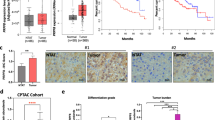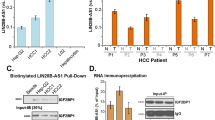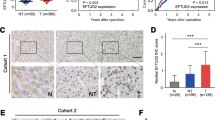Abstract
We have previously identified several novel genes, which are differentially expressed among human normal liver and hepatocellular carcinomas (HCCs). The full-length liver fibrinogen-related gene-1 (LFIRE-1) cDNA was cloned from the human normal liver cDNA library. LFIRE-1 is highly homologous to HFREP-1 with discrepancy at 5′ untranslated region (UTR) and encodes the same fibrinogen-related protein, which suggest that these two sequences might be alternative splicing forms of the same gene, LFIRE-1/HFREP-1, located at human chromosome 8p22. The LFIRE-1 and HFREP-1 are specifically expressed in normal human liver tissue, but reduced or undetectable in most of HCC specimens at both RNA and protein level. Furthermore, the reduction or nonexpression of LFIRE-1/HFREP-1 is significantly associated with the degree of tumor differentiation. Loss of heterozygosity (LOH) analysis revealed allelic loss of LFIRE-1/HFREP-1 on chromosome 8p22 in 57.1% (24/42) of HCC specimens. We detected three inactivation mutations among 45 cases of HCC specimens examined, two of which lost the remaining allele and the third had a replacement of conserved cysteine residue with glycine residue. Notably, the downregulation of LFIRE-1/HFREP-1 expression is frequently associated with allelic loss. The reduction of LFIRE-1/HFREP-1 expression by antisense approach enhances cancer cell proliferation and colony formation in soft agar. Moreover, restoration of exogenous wild-type LFIRE-1/HFREP-1 expression but not LFIRE-1/HFREP-1 missense mutations in human HCC cells inhibited their anchorage-dependent or -independent growth in vitro, and suppressed their tumorigenicity in nude mice. In conclusion, our data demonstrated that liver-specific gene LFIRE-1/HFREP-1 was frequently downregulated and might possess growth suppressor activity in HCC.
This is a preview of subscription content, access via your institution
Access options
Subscribe to this journal
Receive 50 print issues and online access
$259.00 per year
only $5.18 per issue
Buy this article
- Purchase on Springer Link
- Instant access to full article PDF
Prices may be subject to local taxes which are calculated during checkout







Similar content being viewed by others
References
Altschul SF, Boguski MS, Gish W and Wootton JC . (1994). Nat. Genet., 6, 119–129.
Bishop JM . (1987). Science, 235, 305–311.
Buendia MA . (2000). Semin. Cancer Biol., 10, 185–200.
Chan KL, Lee JM, Guan XY, Fan ST and Ng IO . (2002). Cancer, 94, 3179–3185.
Chang YC, Yu YL, Wang N and Xu YH . (2001). Shi Yan Sheng Wu Xue Bao, 34, 319–322.
Chen CJ, Yu MW and Liaw YF . (1997). J Gastroenterol. Hepatol., 12, S294–308.
Chen R, Zhu D, Ye X, Shen D and Lu R . (1980). Sci. Sin., 23, 236–247.
Colombo M . (1992). J. Hepatol., 15, 225–236.
Emi M, Fujiwara Y, Ohata H, Tsuda H, Hirohashi S, Koike M, Miyaki M, Monden M and Nakamura Y . (1993). Genes Chromosomes Cancer, 7, 152–157.
Farrell DH and Thiagarajan P . (1994). J. Biol. Chem., 269, 226–231.
Fearon ER and Vogelstein B . (1990). Cell, 61, 759–767.
Feinberg AP . (2001). Proc. Natl. Acad. Sci. USA, 98, 392–394.
Hanahan D and Weinberg RA . (2000). Cell, 100, 57–70.
Haydon GH and Hayes PC . (1995). Br. J. Hosp. Med., 53, 74–80.
Hermann S, Sturm I, Mrozek A, Klosterhalfen B, Hauptmann S, Dorken B and Daniel PT . (2001). Int. J. Cancer, 92, 805–811.
Ho SN, Hunt HD, Horton RM, Pullen JK and Pease LR . (1989). Gene, 77, 51–59.
Jones PA and Laird PW . (1999). Nat. Genet., 21, 163–167.
Knudson AG . (1993). Proc. Natl. Acad. Sci. USA, 90, 10914–10921.
Kuroki T, Fujiwara Y, Tsuchiya E, Nakamori S, Imaoka S, Kanematsu T and Nakamura Y . (1995). Genes Chromosomes Cancer, 13, 163–167.
Mironov AA, Fickett JW and Gelfand MS . (1999). Genome Res., 9, 1288–1293.
Modrek B and Lee C . (2002). Nat. Genet., 30, 13–19.
Nagai H and Buendia MA . (1998). Koshy R, Caselmann WH (eds). Hepatitis B Virus: Molecular Mechanisms in Disease and Novel Strategies for Therapy. Imperial College Press: London, pp. 182–218.
Pineau P, Nagai H, Prigent S, Wei Y, Gyapay G, Weissenbach J, Tiollais P, Buendia MA and Dejean A . (1999). Oncogene, 18, 3127–3134.
Procopio WN, Pelavin PI, Lee WM and Yeilding NM . (1999). J. Biol. Chem., 274, 30196–30201.
Qiang S, Yaoting Y, Hongyin L and Klinkmann H . (1997). Int. J. Artif. Organs, 20, 119–124.
Qin LX, Tang ZY, Sham JS, Ma ZC, Ye SL, Zhou XD, Wu ZQ, Trent JM and Guan XY . (1999). Cancer Res., 59, 5662–5665.
Sherman M . (1995). Gastroenterologist, 3, 55–66.
Yan J, Ying H, Gu F, He J, Li Y, Liu H and Xu Y . (2002). Cell Res., 12, 353–361.
Ying H, Yu Y and Xu Y . (2001a). Biochem. Biophys. Res. Comm., 286, 394–400.
Ying H, Yu Y and Xu Y . (2001b). Oncol. Res., 12, 485–490.
Yamamoto T, Gotoh M, Sasaki H, Terada M, Kitajima M and Hirohashi S . (1993). Biochem. Biophys. Res. Commun, 193, 681–687.
Zhu H, Ye X and Chen R . (1981). Zhonghua Zhongliu Zazhi, 3, 241–244.
Acknowledgements
We thank Dr Glenn T Merlino for critical reading and helpful suggestion of the manuscript and Dr Wolfgang Hennig for discussions. This work was supported by Major State Basic Research (973) Program of China (G1999053905) and National Natural Science Foundation of China (30170207).
Author information
Authors and Affiliations
Corresponding author
Rights and permissions
About this article
Cite this article
Yan, J., Yu, Y., Wang, N. et al. LFIRE-1/HFREP-1, a liver-specific gene, is frequently downregulated and has growth suppressor activity in hepatocellular carcinoma. Oncogene 23, 1939–1949 (2004). https://doi.org/10.1038/sj.onc.1207306
Received:
Revised:
Accepted:
Published:
Issue Date:
DOI: https://doi.org/10.1038/sj.onc.1207306
Keywords
This article is cited by
-
PHLPP1 mediates melanoma metastasis suppression through repressing AKT2 activation
Oncogene (2018)
-
Runx2 promotes both osteoblastogenesis and novel osteoclastogenic signals in ST2 mesenchymal progenitor cells
Osteoporosis International (2012)
-
Experimental models of hepatocellular carcinoma: developments and evolution
Journal of Cancer Research and Clinical Oncology (2009)
-
Positional expression profiling indicates candidate genes in deletion hotspots of hepatocellular carcinoma
Modern Pathology (2006)
-
DDX3, a DEAD box RNA helicase, is deregulated in hepatitis virus-associated hepatocellular carcinoma and is involved in cell growth control
Oncogene (2006)



